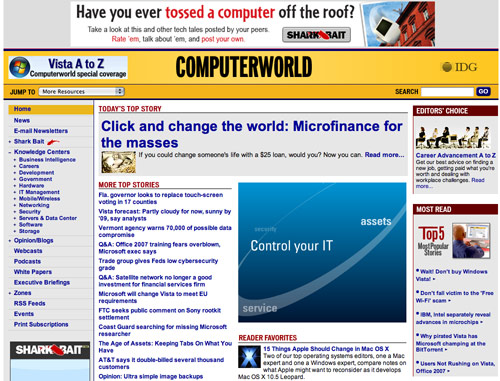Lead Generation Websites generate revenue by providing sponsors with qualified leads.
Users shop for products and services in an effort to save time and money, while the seller pays for content creation and co-branding value. Plus, the seller pays a transaction fee for each qualified lead.
In this chapter, we profile two very different lead-generation sites: Lending Tree in the B2C financial space and Computerworld, a B2B technology website network that provides leads for technology companies hoping to sell to information systems executives.

Key Concepts
Business Goal: Generate revenue by providing sponsors with qualified leads.
User Goals: Shop for products and services while saving time and money.
Revenue Model: Seller pays for content creation and co-branding value; plus seller pays a transaction fee for each qualified lead.
Content: Generated by both sponsor and publisher in a variety of combinations.
Navigation: Initial information architecture is topic-based and designed to aide the user in finding the desired information, similar to a Membership Website; secondary information architecture is transactional in nature, similar to a Retail Product Website, where the goal is maximum conversion rates.
Two very different lead-generation sites are profiled here, Lending Tree in the B2C financial space and Computerworld, a B2B technology website network that provides leads for technology companies hoping to sell to information systems executives.
[text_ad]
LendingTree
One Simple Form, Compare and Act on Up to Four Customized Offers Instantly!
Web watchers were skeptical when LendingTree launched in 1998. Despite the surging use of the Internet during the 1990s, those in the know had doubts whether consumers would trust posting their financial information online. For that very reason, banking institutions, as you may recall, were among the slowest—let’s say the most careful—to transact business via the Web. Privacy issues remain, of course, but LendingTree LLC has proven that consumers are very much interested in shopping online—even for loans—and lenders, in turn, are willing to pay for those leads.
LendingTree receives referral fees for each closed loan on LendingTree.com and a percentage of the agent commission from each closed home purchase or sale generated on the RealEstate.com site. LendingTree also receives a small lead-generation fee from its lender partners each time the lenders receive a loan application generated by the LendingTree.com site.

With more than 2.3 to 4.6 million unique monthly U.S. visitors in 2006, Lending Tree is America’s most popular lead generation website. The site includes almost 30,000 pages of content and more than 521,000 inbound links. LendingTree is a part of Barry Diller’s InterActiveCorp, (IACA) which had 2006 revenue of about $6.4 billion.
Computerworld
Website will Generate Almost as much Top-line Revenue and Higher Profits in 2006 than Print Sibling
Computerworld‘s websites are designed to draw in all buyers of high technology, sort them out by the products or services with which they are involved, and deliver their name and some information about them (if possible) to high tech marketers. Finding and qualifying high-tech buyers is the plan.

To draw people into this figurative funnel, Computerworld starts by using its print publication to direct people to the website. But it also uses search engine optimization, public relations, and cooperative efforts with other sites. For example, Computerworld.com swaps links with some sites, and provides summaries of its information to others. To get the whole story, the reader has to click onto Computerworld.com.
This strategy produces between 1.5 and 2 million unique visitors per month. Some are regular visitors, but many are transient, usually looking for just one thing.
Perhaps the most sophisticated use of this technique is the “white paper.” Either vendors supply white papers—usually on highly technical subjects—or Computerworld writes them for the vendor. They are then offered free to those who qualify themselves. Vendors are willing to pay a great deal for these highly qualified prospects.
Another of its website pages, IDG Executive Briefings, sells downloadable white papers at an average price of $195.
And yet another website, IDG Connect, has positioned itself as “the source for white papers, webcasts, podcasts, blogs, research, case studies and product information.”
With unique U.S. visitors ranging from 117,000 to 193,000 across 2006, Computerworld’s website will generate almost as much top-line revenue in 2006 as its print sibling—and much higher profits, according to IDG CEO Patrick J. McGovern.
With 940,000 pages of content, and more than 3.1 million inbound links, this website is not only the B2B flagship for IDG USA, but for Computerworld’s 32 global editions.
This article was written by Don Nicholas with the help of Peter A. Schaible. It is only one part of a series on Internet Business Models. See below for the rest of this series:



nice job. I